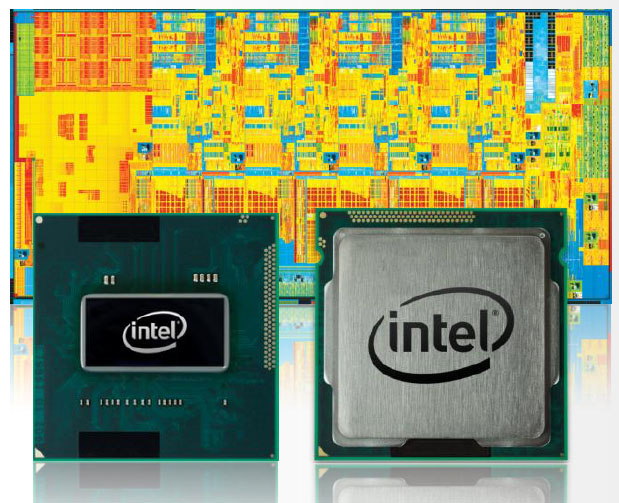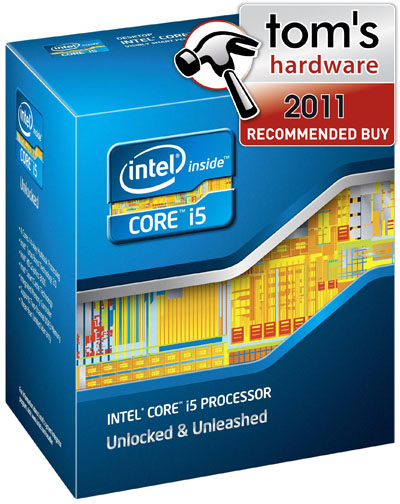Intel’s Second-Gen Core CPUs: The Sandy Bridge Review
Although the processing cores in Intel’s Sandy Bridge architecture are decidedly similar to Nehalem, the integration of on-die graphics and a ring bus improves performance for mainstream users. Intel’s Quick Sync is this design’s secret weapon, though.
Conclusion
No doubt, there’s a lot going on in this launch. The Sandy Bridge introduction hits a number of high notes that have me dusting off an award, while simultaneously compelling me to cringe at a couple of Intel’s clumsier moves.
Let’s start with the bad, so I can wrap up on a positive note for the New Year.
Overclocking isn’t handled well at all. Really, the only viable option for power users is a K-series SKU. That’s not entirely bad, of course. Less than one year ago, the only unlocked option in Intel’s portfolio was priced at $999. The fact that we have a couple of choices in the $200 and $300 ranges is great. But the limited overclocking (Core i5/i7) and outright lack of options (Core i3) strikes a sour chord sure to burn off a lot of the enthusiast equity Intel earned by launching the K-series chips last year.
The graphics situation, at least on the desktop, is also pretty whacky. Of the 14 models introduced at launch, the two best suited to enthusiast-oriented gaming machines with discrete GPUs are the ones armed with Intel’s HD Graphics 3000 engine. The other 12—conceivably candidates for more mainstream gaming builds, office desktops, and HTPCs—sport the downright average HD Graphics 2000 implementation.
Those two gripes out of the way, how could we not be impressed by Sandy Bridge’s performance? Existing Lynnfield- and Clarkdale-based processors already offer strong performance compared to AMD’s lineup. Significant gains, clock-for-clock, compound in the face of notable frequency increases across the board (thanks to a mature 32 nm process), giving Sandy Bridge an even more commanding position.
I’m also a big fan of Quick Sync. Neither AMD nor Nvidia have an answer to Intel’s decode/encode acceleration, and they’re not expected to any time soon. If you do a lot of video editing or transcoding, an upgrade to Sandy Bridge might be warranted based solely on the time you’ll save by virtue of this feature. Kudos to Intel for getting developer support lined up right out of the gate, too. If the graphics guys could rally the software industry as quickly, we'd already be swimming in CUDA- and APP-accelerated titles.
If there was one Sandy Bridge-based SKU that I’d personally recommend to friends and family building new PCs, it’d be the Core i5-2500K. Its performance relative to AMD’s lineup and the rest of Intel’s stack is noteworthy—especially given its price tag just north of $200. The i5-2500K circumvents Sandy Bridge's overclocking challenges with an unlocked multiplier, and I'm counting on gamers to drop it onto a P67-based motherboard, skirting the integrated graphics debate entirely.
Get Tom's Hardware's best news and in-depth reviews, straight to your inbox.
And while this is only the second time in two and a half years that I’ve dusted off the Recommended Buy award for a very deserving processor, you’d better believe I have an eye to the future, waiting to see how AMD’s Bulldozer architecture contends with Intel’s ever-plodding tick-tock cadence.
For a chance at winning your own Core i7-2600K-based PC, please click this link to enter our CyberPower PC/Tom's Hardware contest. The system's specs are as follows:
- Intel Core™ i7-2600K LGA 1155
- Thermaltake Armor A60 Mid-Tower Chassis
- Asus P8P67 Pro LGA 1155 ATX Mainboard
- Asus ENGTX 460 Video Card
- Asus BC-08B1LT 8x Blu-ray Player & DVD-RW Combo
- Kingston 4 GB (2 x 2 GB) DDR3-1600 Dual-Channel Memory Kit
- Maximum 120 mm Case Cooling Fans
- Thermaltake Frio CPU cooler
- 1 TB SATA 6 Gb/s 64 MB Cache 7200 RPM HDD
- Microsoft® Windows® 7 Home Premium
- Thermaltake 600 W Power Supply
Contest is limited to residents of the USA (excluding Rhode Island) 18 years of age and older. Contest starts on January 2, 2011 9:00 PM, Pacific Standard Time and closes on January 17, 2011 11:59 PM, Pacific Standard Time.
Results will be announced by January 21, 2011.
The information you provide will only be used to contact you in relation to this contest.
YOU MAY SUBMIT ONLY ONE ENTRY. MULTIPLE ENTRIES FROM THE SAME PERSON WILL ALL BE DISCARDED.
-
cangelini MoneyFace pEditor, page 10 has mistakes. Its LGA1155, not LGA1555.Reply
Fixed, thanks Money! -
juncture "an unlocked Sandy Bridge chip for $11 extra is actually pretty damn sexy."Reply
i think the author's saying he's a sexually active cyberphile -
fakie Contest is limited to residents of the USA (excluding Rhode Island) 18 years of age and older.Reply
Everytime there's a new contest, I see this line. =( -
englandr753 Great article guys. Glad to see you got your hands on those beauties. I look forward to you doing the same type of review with bulldozer. =DReply -
joytech22 Wow Intel owns when it came to converting video, beating out much faster dedicated solutions, which was strange but still awesome.Reply
I don't know how AMD's going to fare but i hope their new architecture will at least compete with these CPU's, because for a few years now AMD has been at least a generation worth of speed behind Intel.
Also Intel's IGP's are finally gaining some ground in the games department. -
cangelini fakieContest is limited to residents of the USA (excluding Rhode Island) 18 years of age and older.Everytime there's a new contest, I see this line. =(Reply
I really wish this weren't the case fakie--and I'm very sorry it is. We're unfortunately subject to the will of the finance folks and the government, who make it hard to give things away without significant tax ramifications. I know that's of little consolation, but that's the reason :(
Best,
Chris -
LuckyDucky7 "It’s the value-oriented buyers with processor budgets between $100 and $150 (where AMD offers some of its best deals) who get screwed."Reply
I believe that says it all. Sorry, Intel, your new architecture may be excellent, but unless the i3-2100 series outperforms anything AMD can offer at the same price range WHILE OVERCLOCKED, you will see none of my desktop dollars.
That is all.


